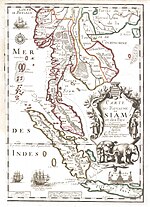| History of Thailand |
|---|
 |
|
|
The history of Isan (Thai: อีสาน, pronounced [ʔiː sǎːn]) has been determined by its geography, situated as it is on the Korat Plateau between Cambodia, Laos, and Thailand.
The national government claimed that the name "Isan" was derived from Sanskrit Īśāna, a name of Shiva they claimed referred to his rule of the northeast (Sanskrit īśānya).[1] This interpretation was intended to reinforce Isan's identity as the northeast of Thailand, rather than as part of the Lao kingdom because of the fear of the Lao people seceding.
The Thai king Vajiravudh reinvoked the ancient name, designating the northeast sector of the Rattanakosin Kingdom "Isan". Previously, in the reign of Chulalongkorn in early 20th century, the sector was generally called Hua Mueang Lao (Lao Townships หัวเมืองลาว) for the area north of Nakhon Ratchasima (Korat) and Khamen Pa Dong (Wilderness Khmer, เขมรป่าดง) for the townships to the east. Later, the term Isan came into wide, if unofficial, use as a term for the northeastern region, and khon Isan (Isan people, คนอีสาน) as a general term for the peoples of Isan.
Isan has been dominated by each of its neighbors in turn, although its relative infertility meant it was more often a battleground than a prize. Rather than being incorporated into the respective empires of each power, the area was divided into mueang ("city-states", เมือง), each paying tribute to one or more powers under the mandala system.
Throughout the 20th century, the Thai government took steps to cement Isan's status as a part of Thailand and to de-emphasize the Lao, Khmer and Kuy origins of its population, a process known as Thaification.

The majority of people in present-day Isan speak the Lao language known as Isan. Many Khmer speakers live in the southern half and substantial minorities of Katuic speakers (i.e., Kuy, Bru, and So) also exist. Most Isan people are both conversant and to some degree literate in Central Thai. Before the central government introduced the Thai alphabet and language in regional schools, the people of Isan wrote in the Lao alphabet, a very similar script that Thai adopted. Most people still speak the Isan language, a dialect of the Lao language, as their first language. A significant minority in the south also speak Northern Khmer.
The Kuy people, an Austroasiatic people concentrated around the core of what was once the Chenla Kingdom and known as the Khmer Boran "ancient Khmer", are a link to the region's pre-Tai history.
- ^ Royal Institute - 1982: อีสาน ๑
